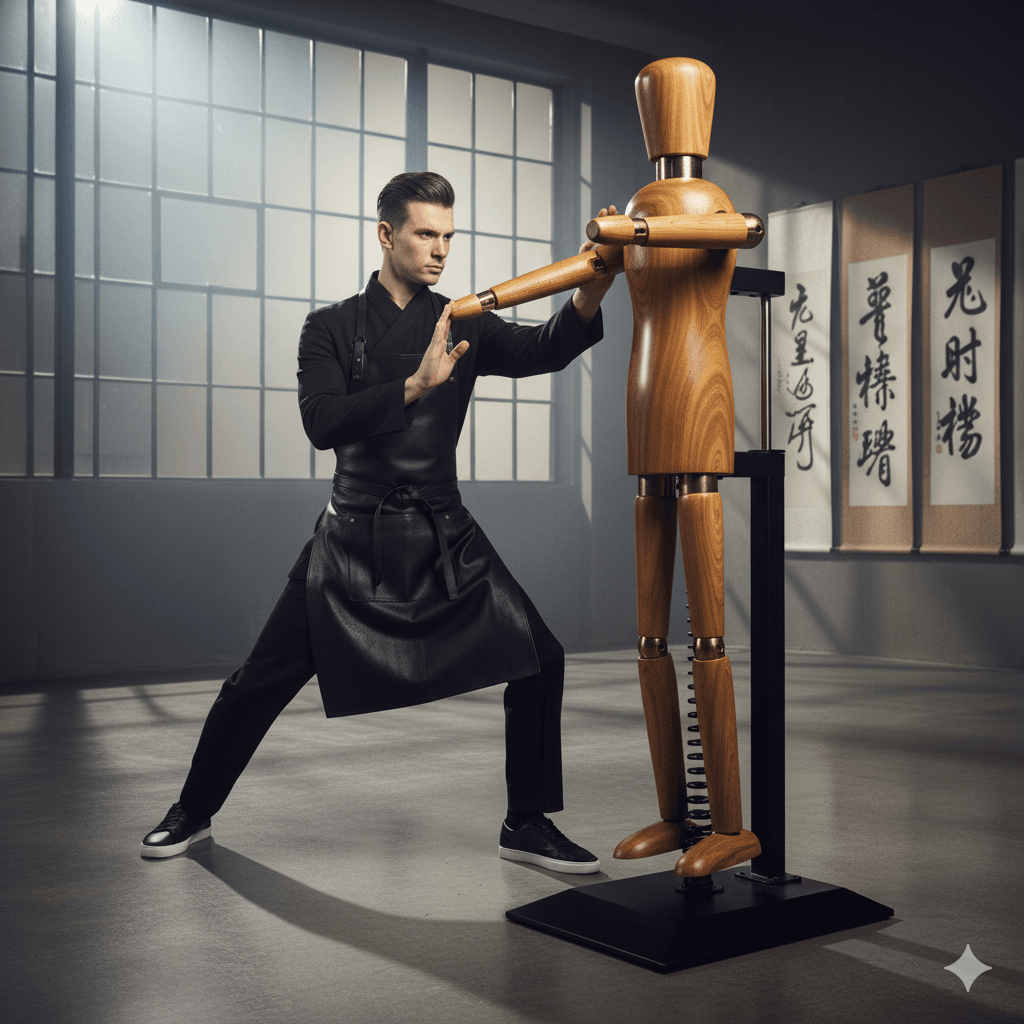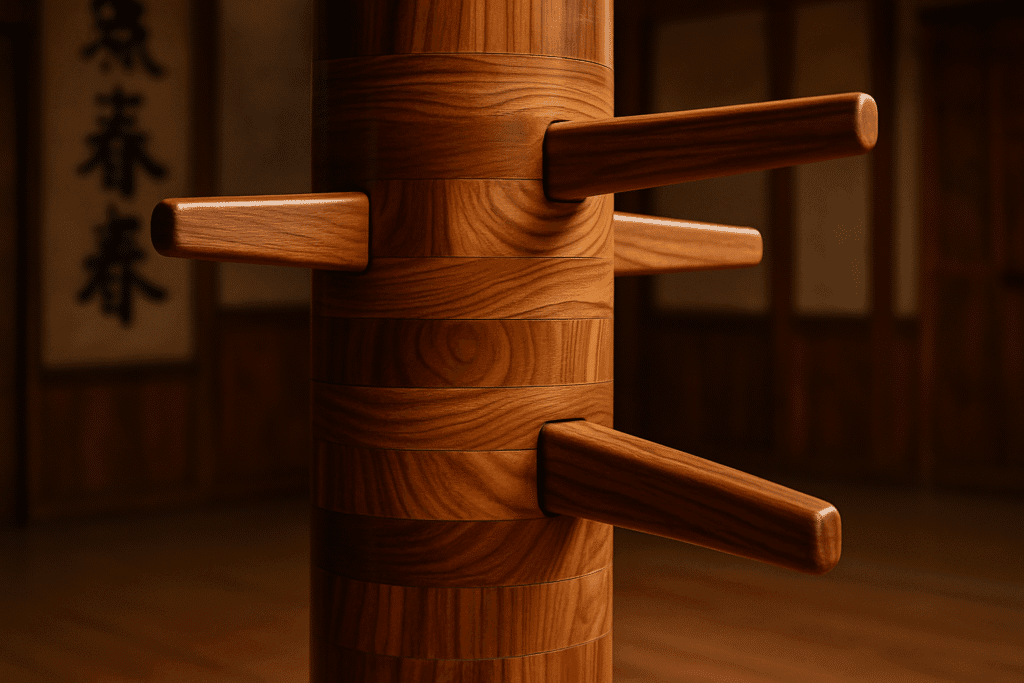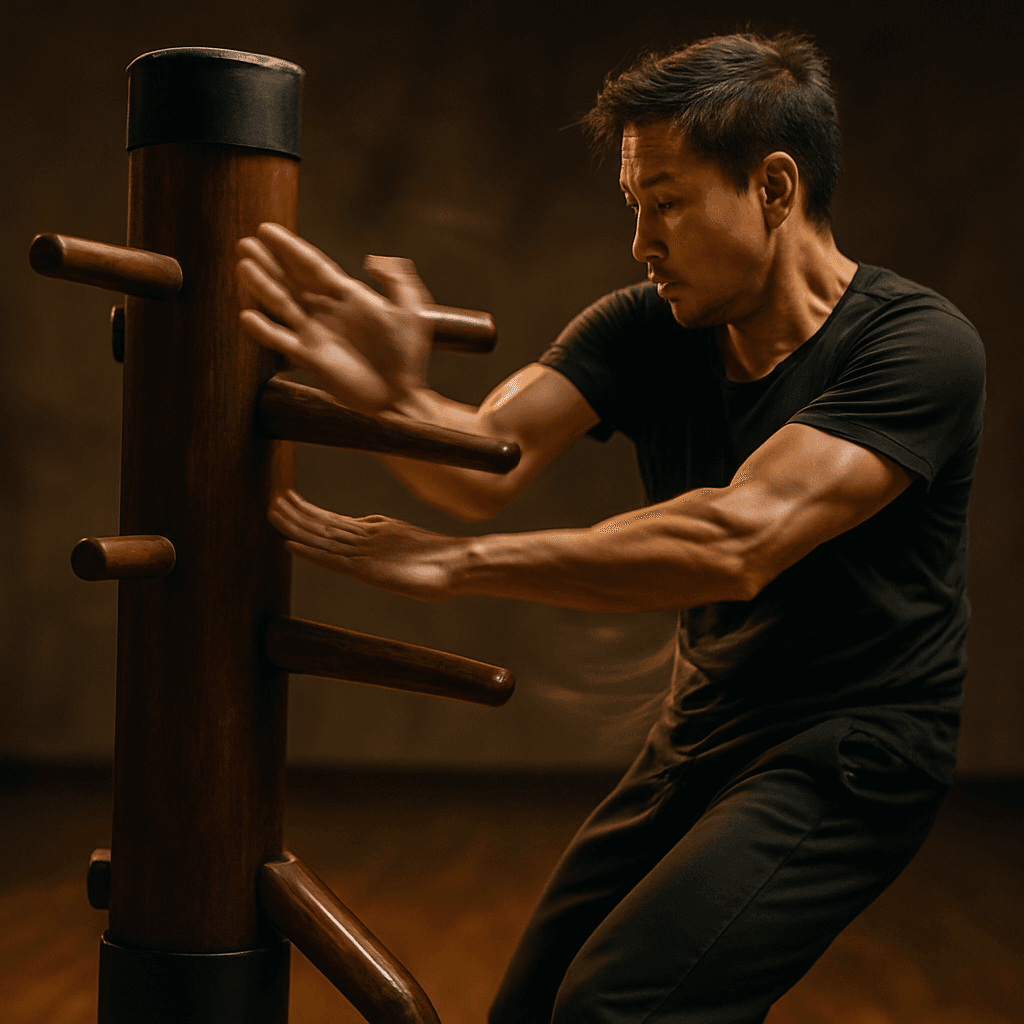For the serious Wing Chun practitioner, the Mook Yan Jong (Wooden Dummy) is not a decorative object; it is a fundamental training tool.
Moving beyond beginner-level practice requires a Jong that can withstand intense, repetitive force while providing accurate feedback.
This guide cuts through the history and philosophy to focus solely on the professional types of dummies available, their construction, and the critical features that separate a training tool from a piece of furniture.
The Three Pillars of Professional Jong Design
Professional dummies are categorized primarily by their mounting system, which drastically affects their training feedback and required installation.

1. The Wall-Mounted Jong
This is the most traditional and rigid type of dummy, offering zero give.
Construction & Mounting: The trunk is mounted directly onto a sturdy frame or bracket that is solidly anchored into wall studs or a concrete wall. There is no movement or flex in the system.
Professional Purpose: It is the ultimate tool for developing rooting, structure, and precision. Because it does not yield, any error in your angle, stance, or technique is immediately and painfully apparent. It forces you to generate power from your stance and body structure rather than relying on momentum.
Ideal For: Serious schools, traditionalists, and practitioners focused on refining the exact angles and devastating, penetrating power of their techniques. It is the standard for most classical Wing Chun lineages.
2. The Spring-Frame / Frame-Mounted Jong
The modern evolution and arguably the most popular type for professional use. It offers a dynamic, reactive training experience.
Construction & Mounting: The Jong’s trunk is mounted to a free-standing A-frame or rectangular frame via two or three large, heavy-duty springs. These springs allow the entire dummy to recoil and swing when struck with force.
Professional Purpose: It trains absorbing energy, continuous flow, and fighting rhythm.
The rebound effect forces you to stay relaxed and chain your techniques together to control the dummy’s movement.
It simulates the dynamic energy of a live opponent more closely than a wall-mounted model.
Ideal For: Practitioners who want to bridge the gap between form and sparring. It develops fluidity, timing, and the ability to maintain structure against a moving, resisting force.
3. The Freestanding / Self-Standing Jong
A versatile modern solution that uses weight and design instead of fixed mounting.
Construction & Mounting: The dummy is attached to a heavy, weighted base (often filled with sand, water, or concrete) that provides stability.
No installation is required; it is a single, movable unit.
Professional Purpose: Convenience and portability without completely sacrificing functionality.
A high-quality, professionally weighted freestanding dummy can be 90% as effective as a mounted model for most drills.
The key is a massively heavy base to prevent tipping and excessive wobble.
Ideal For: Home gyms, apartments (with caution regarding noise), or schools where drilling into walls/floors is not possible. The critical factor is total weight—a professional model will have a base weighing over 150 lbs (68 kg).
Key Features of a Professional Grade Dummy
Beyond the mount, these construction details are non-negotiable for professional use.
1. Wood Type and Quality
Professional: Hardwoods are mandatory.
Maple is the gold standard for its incredible density, durability, and resistance to cracking.
Chinese Fir or Redwood are also excellent traditional choices.
The trunk should be made from a single, vertically laminated piece of wood to prevent splitting along the grain under repeated impact.
Avoid: Softwoods like pine, cheap plywood, or trunks made from multiple horizontal blocks glued together.
These will dent, crack, and break.
2. Arm and Leg Construction
Professional: Arms and legs should be made from the same high-density hardwood as the trunk.
They must be through-tenoned—meaning the tenon (the end of the arm) passes completely through the trunk and is secured with a wedge or pin on the other side.
This is the only construction that can withstand a lifetime of pounding.
Avoid: Arms that are simply screwed in or glued.
These will loosen and fail quickly.
Thin, lightweight arms that flex or feel hollow.
3. Dimensions and Geometry
Professional: The angles and lengths of the arms are not arbitrary.
They are designed to represent the specific gates and lines of attack in Wing Chun.
A professionally crafted Jong will adhere to the precise measurements and angles of its intended lineage (e.g., Yip Man, Yuen Kay-San, etc.).
The diameter of the arms should be substantial (typically 1.5″ to 1.75″) to develop strong conditioning.
4. The Spring System (For Frame-Mounted Jongs)
Professional: Features thick, heavy-duty steel springs with a high coil count.
The springs are securely mounted with robust bolts and washers.
This system provides a strong, consistent rebound without being too loose or too stiff.
Avoid: Thin, lightweight springs that feel like they belong on a screen door. These will deform quickly and provide inconsistent feedback.
Choosing Your Professional Tool
For the Purist: A Wall-Mounted Maple Jong with through-tenoned arms is the ultimate choice for developing impeccable technique and power.
For the All-Rounder: A Spring-Frame Mounted Jong offers the best blend of traditional feedback and dynamic, fight-applicable movement.
For the Practical Home Practitioner: A high-weight Freestanding Jong (200+ lbs / 90+ kg total weight) with a hardwood trunk and arms is a legitimate professional tool that requires no permanent installation.
Investing in a professional Mook Yan Jong is investing in the quality of your Wing Chun.
It is the partner that never gets tired, never complains, and always tells you the truth about your structure, power, and technique.
Choose the type that aligns with your training goals and space, but never compromise on the quality of materials and construction.
Your hands and your art deserve it.






